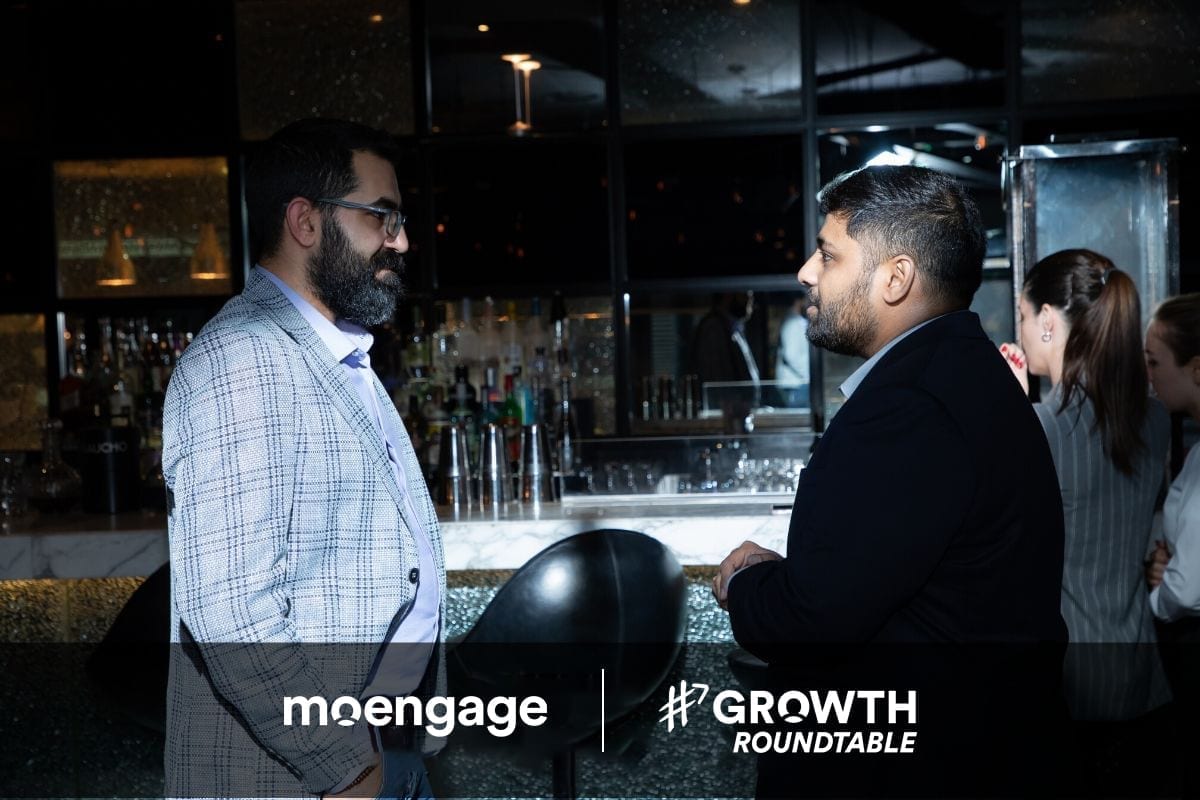#Growth Dubai Roundtable: How Mobile-First and Enterprise Companies Employ Personalization in Marketing Automation

Reading Time: 6 minutes
We recently concluded the insightful #Growth Dubai round table. Leaders from some of the fastest-growing companies of the 21st century, Careem, Emirates NBD (Liv), CASHU, Mashreq Bank, Emaar, to name a few, attended the event.
What’s a #Growth roundtable event?
At MoEngage we believe that creating communities, sharing insights, and learning from each other is an important cornerstone of a thriving business. #Growth roundtables are closed-group events for leaders from different industries to come together as a community and share industry nuances.
Naturally, this event is a grand success when the participants walk out much more informed than before. The professional camaraderie transforms into free-flowing conversations. Participants discuss solutions for problems that they face together as a community.
The Topic
The topic of the Dubai roundtable was pertinent – How do companies personalize user experiences to create long-lasting customer relationships?
With the rise of mobile, a new view of customer/brand engagement is emerging. The age of the customer marked the end of the one-size-fits-all messaging era. Today, a single message can’t get the job done unless it’s perfectly tailored to relate with every customer. This is the age where customers are more empowered than ever before and in control of their relationship with a brand. These customers continually demand personalization throughout the buying journey.
Mobile-First Vs Enterprises
Broadly speaking the participants of the Dubai roundtable can be categorized into two industry segments – Mobile-First and Enterprises. While mobile-first companies keep themselves abreast of the recent technological solutions for marketing problems and ways to implement them, enterprises are still playing a catch-up game.
Those of you who understand the differences between a mobile-first company and an enterprise can skip the next section and go directly to the insights.

1. What is a Mobile-First company?
The term “Mobile-First’ was introduced by Luke Wroblewski in his book of the same name.
“Mobile-first” signifies a design approach where you start with a focus on mobile experiences. Such companies begin with smaller screen resolutions and work their way up to larger screens with a unified experience. For modern businesses, this approach focuses equally on both versions – mobile web and applications. Examples include eCommerce, food delivery, travel, etc.
2. What is an Enterprise?
In the traditional sense, enterprises are companies with substantial manpower, processes, and customers. An enterprise may or may not have a digital revenue stream. These companies generally do not have a vibrant digital presence. Their customers, on the other hand, do. This change in the landscape and rapid boost in digital engagement have forced enterprises to re-think the way they approach digital channels. Examples are companies in sectors such as BFSI, real estate, etc.
If interested, take a look at Challenges of Enterprise Marketing Teams and How to Solve Them
So how does personalizing user experiences to create long-lasting customer relationships differ in these two segments?

Unlocking unified data view of customers
| Mobile First | Enterprises |
| Actionable data present | Data Paralysis |
| Digital customer journey is better mapped | Less visibility of digital customer journey |
| Departments/teams are cross-functional | Departments/teams usually work in silos |
Actionable Insights:
- Data needs to be more holistic in order to be acted upon. For a brand, it’s important to analyze user behavior across different lifestyle segments.
Case in point: One of the marketers from the Banking industry remarked how they engaged their customers by telling them that they spent $xx on coffee this month. This in turn nudged the viewer to create an expense tracker. This is a classic example of how brands can expand their engagement strategy by creating a unified view of the customers across different touchpoints. - A good way to start battling data paralysis and analyzing user behavior is by setting trackers within the native app/website. This helps you map the user journey and plug the leaky buckets (pages with considerable drop-offs). This will also be a good starting point for tracking the effectiveness of your future campaigns.
- Setting up growth teams that don’t work in silos. Cross-functional teams that span across Data Science, IT, and Marketing communications roll out much more effective campaigns.

Personalization Strategies To Create Effective Campaigns
| Mobile First | Enterprises |
| When to send a message could be a challenge | What to send in a message and when – both are a challenge |
| Messages are less promotional, more useful | Messages are partly or fully promotional |
| Partnered with other lifestyle brands to drive engagement | Partnerships are still being explored |
Actionable Insights
- Keep your messages less promotional and more useful to drive better engagement. One of the attendees – a marketer from the Travel industry – remarked how geofencing had really helped them in driving more impressions. Here are some ways to make your messages more useful, relevant, and personalized. Furthermore, keep in mind that running promotions can invite unwanted segments that don’t give you the expected return on investments.
- Segment your users not based on hunches but on actual data points. For example, a participant from the Banking industry shared how accounting a user’s expenditure on other brands can be a far better indicator of their purchasing power than the traditional revenue-based model, which only takes into account the user’s relationship value with the bank. Expanding the datasets and getting a 360-degree view of your customer is inevitable in this day and age.
- Start by generating lookalikes for user acquisition: Once you have your ideal user persona in place, look for similar users who fall in the same category. This same approach can be extended to social media channels such as Facebook which gives you the option to actively target ads to your lookalike audience.
- Partnerships with other brands further enrich your personalization toolkit. Your users are interacting with multiple brands, and that opens up a plethora of opportunities to analyze user behavior and drive value for your brand.

How to ensure that your personalized messages don’t get creepy
- Be mindful of who you’re creating the campaign for. Factors such as nationality, age groups play a big role here.
- Make your campaigns loosely on the lines of user behavior and patterns rather than being too specific. For example, if a user has opened a savings fund with the name “Marriage savings”, you’re better off sending them messages which are around the family theme than marriage itself.
- Time the message notification to perfection. It’s important that the message gets delivered at the right time to increase the likelihood of an impression. Setting a start and end time for your campaign is not enough. Enable your campaigns with the timezones that your users are in. There’s still space for machine-learning-driven tools to make the delivery more specific and customized to each user.
Bonus: How do brands extend customer service on Social Media
- For the loyal advocates: Identifying your brand advocates and rewarding/recognizing them on social media is a small step with great benefits.
- For the unhappy customer:
– Acknowledge the complaint and respond to emails. Keep in mind that if you try to solve the complaint over social media, you’re indirectly encouraging other users to do the same. The last thing you want is for your social media handles to transform into a complaint board.
– Angry customers are good for business. There’s a huge opportunity to convert them into loyalists by compensating them with your best service.
Conclusion: Vision for future years
- Create a diverse set of products that caters to growing market needs. Have the marketing team on board at the stage of product conceptualization.
- Go with quality over quantity when it comes to creating campaigns.
- Ensure seamless integration between teams internally. Set up real teams, not silos.
- Expand the product platform to create an ecosystem around it. For example, a travel app expanding into an e-payment wallet that integrates with other brands.
Here’s What You Should Do Next
|







